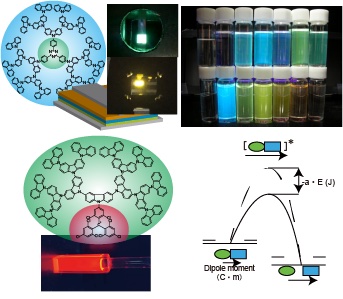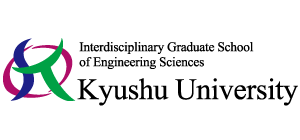検索キーワード:Devices
[Category Ⅰ] Theory of Functional Mateirals
Science and Engineering of Materials and Devices
Prof. Kengo Shimanoe , Associate Prof . Ken Watanabe , Assistant Prof. Koichi Suematsu,
Labo Site
Development will be expected more and more assuming that the key to new science and technology construction is gripped as for various devices (elemenet) taat use functional materials in the future. As for physical properties of functional materials. it depends on not only the buk but also the structure and the organization. etc. on the surface and he deld sce, and the control and the optimization of cose varbus factors are onemos: moerant for the device comburecon nins caring area as as the creation of the followme new or lead ancion devices, examines within the wide range omene design and re synthesis of new functional materials to the analysis of ue structure etc., the device constructor and evaluation of characteristics and the research is developed.
Gas sensor、All-solid-state battery, Oxygen permeable membrane, Functional materials, Nano, wet processing, Ion conductor, Mixed conductor, Semiconductor, Metal oxide
[Category Ⅰ] Structural Materials Science
Science and Engineering of Materials and Devices
Associate Professor Masatoshi Mitsuhara,
Labo Site
The mechanical properties of metallic and ceramic structural materials strongly depend on the microstructure, which includes the atomic configuration of the material and its irregularities. We are conducting research to clarify the relationship between the mechanical properties and the microstructure in order to design new structural materials with superior properties needed for structural and functional applications. Our experimental tools are mechanical tests such as "tensile test", "compression test", "hardness test", "creep test" and microstructual observation and analysis with electron microscopy.
・Deformation and fracture in metallic structural materials
・Creep deformation and strengthening mechanism in heat-resistant alloys
・Development of new heat-resistant alloys
[Category II] Functional Device Engineering Laboratory
Device Science and Engineering
Professor Wang Dong , Assistant Professor Yamamoto Keisuke,
Labo Site
Our laboratory is researching new technologies such as More Moore, More than Moore, Beyond CMOS, etc. to further improve the performance and functionality of integrated circuits, which are essential components of information and communication equipment. Specifically, we are doing research on Group IV semiconductor process technology (thin film formation / processing technology), device fabrication, electrical and optical evaluation, and relevant technologies for improving the performance of semiconductor devices such as transistors and light-emitting devices. For conducting these studies, various process / evaluation facilities are equipped in a 200 square meter clean room. In our laboratory, "Presentation at the Annual Meetings of Japan Society of Applied Physics (nationwide)" and "Contributing to international conferences" are set as standard tasks for master's course students.
● Development of material and process technologies for advanced CMOS
● Ge photo electronics
● Ge Tunnel FET, Spin MOSFET
● Ge, GeSn-TFT on glass / plastic substrates
● Development of 3C-SiC MOSFET technologies
[Category Ⅰ] Structural Ceramics Materials Laboratory
Science and Engineering of Materials and Devices
[Category Ⅰ] Photo-and Electro-Functional Chemistry
Chemistry and Materials Science
Assoc. Prof. Ken Albrecht,
Labo Site

This laboratory is developing new semiconductors and light-emitting materials based on organic chemistry, photochemistry, and electrochemistry. We are also developing novel reactions catalyzed by "electric fields". Our luminescent materials are mostly based on dendrimer structures that exhibit thermally activated delayed fluorescence (TADF) and luminescence from the doublet states (radicals). The developed materials are applied to light-emitting devices such as organic light-emitting diodes (OLEDs) through solution processes such as printing, and their stimuli-responsive properties are also investigated. As for new catalytic reactions, we are developing reactions in which a strong electric field is applied to organic molecules using an electric double layer or nanogap electrode. The laboratory conducts several domestic and international collaborative research projects and has sent many students abroad.
●Development of dendrimer based organic luminescent materials and application in organic light emitting devices.
●Development of external electric field catalyzed organic reactions.
[Category Ⅰ] Surface Science
Science and Engineering of Materials and Devices
Associate Professor Takeshi Nakagawa,
Labo Site
Surfaces have attracted more interest due to the scaling down of devices. The surfaces are very different from those for bulk, showing unique crystal structures and properties. We reveal novel electronic and magnetic properties of the surfaces and their relationship with atomic structures using low energy electron diffraction, scanning tunneling microscope, Our main targets are two dimensional, single layers of magnetic elements (Fe, Co, Ni), oxides (FeO, SnO) and semiconductors (Si, SiC).
●Preparation of novle single layer materials (ex. metalllic iron, iron oxides, borophene) on metal and semiconductor surfaces.
●Electronic and magnetic peroperties of surfaces
[Category II] Nuclear and Radiation Engineering Physics
Plasma and Quantum Science and Engineering
Professor Yukinobu Watanabe , Associate Professor Tadahiro Kin , Assistant Professor Shoichiro Kawase,
Labo Site
"Nuclear and radiation physics engineering research supporting a safe, secure, and smart future society" We are conducting interdisciplinary research related to physics and medicine/engineering with the aim of cutting-edge application of particle beams such as neutrons and muons to the fields of energy, medicine, space development, etc. Using advanced techniques of experiments, theoretical calculations, and numerical simulations, we are intensively studying the mechanisms of cosmic-rays induced soft errors in semiconductor devices, reduction and resource recycling of high-level radioactive wastes through nuclear transmutation, the development of a new radiopharmaceutical manufacturing method used for diagnosis and treatment of cancer, and deterioration diagnosis of small and medium-sized infrastructure equipment with muography technique, and so on.
・Cosmic-rays induced soft errors in semiconductor devices
・Reduction and resource recycling of high-level radioactive wastes through nuclear transmutation
・Structure perspective with advanced muography technique
・Medical RI production with accelerator neutrons
・Development of advanced radiation detectors and data analysis methods
[Category Ⅰ] Chemistry and Physics of Functional Materials
Science and Engineering of Materials and Devices
Professor Michitaka Ohtaki , Associate Professor Suekuni Koichiro,
Labo Site
This laboratory was established in 2013 focusing on development of energy-oriented novel functional materials based on inorganic materials science, physical and solid state chemistry, and condensed matter physics. It also aims at more comprehensive targets in materials science by combining a wide variety of the properties of inorganic materials and an extensive tunability of organic molecules. The most distinguished achievement of our lab is a pioneering work on oxide and sulfide thermoelectric materials resulting in our continuing accomplishments on the best performances of both n- and p-type bulk thermoelectric oxides. Our perspective, however, is not limited to the thermoelectric materials, but extends to unconventional approaches in materials chemistry and physics for next-generation materials including low-dimensional quantum-confined inorganic nanomaterials spontaneously formed in the presence of self-assembly molecular templates exploiting organic surfactant molecules.
●Oxide- and sulfide-based thermoelectric materials with novel crystal structures, chemical compositions, and nanostructures
●Selectively enhanced phonon scattering by nano-inclusions and nano-heterointerfaces
●Novel material processing for oxide/non-oxide nanocomposite ceramics
●Anomalous solid solubility expansion and its application to unconventional intensive doping by multi-element co-doping
●Layered, caged, and rattling crystal structures and their thermal and electronic properties
●Low-dimensional inorganic nanomaterials spontaneously formed by organic molecular assembly templates and their peculiar quantum properties
[Category II] Opto-Electronics Labgoratory
Device Science and Engineering
Professor Kiichi HAMAMOTO, , Assistant Professor Haisong JIANG, ,
Labo Site
1) Optical breath-sensing toward human daily health-care. One of the target is to realize compact sensing chip which will be integrated cell-phone and other mobile devices.
2) Extremely high-speed laser diode. The target is to realize Tbps direct-modulation by using active-MMI technology.
3) Mode-division-multiplexing device. One of the target is to realize 1,000 times higher transmission capacity. We have realized the world-first optical mode swith for this purpose.
[Category Ⅰ] Materials Structure Design
Science and Engineering of Materials and Devices
Professor Satoshi Iikubo , Associate Prof. Yusuke shimada,
Labo Site
We are developing next-generation structural and functional materials from the perspectives of condensed matter physics and microstructures of materials.First-principles calculations, which reveal the electronic states of substances and calculation of phase diagrams method, are used to explore new materials and control the microstructures. These calculation techniques are applied to solar cells, thermoelectric materials, rechargeable batteries, etc.
●Exploration of new materials using first-principles calculation and phase diagram
●Development of microstructural design using thermodynamic database
●Analysis of crystal structures using X-ray and neutron
[Category II] Electronic Physical Device Engineering
Device Science and Engineering
Professor Tsuyoshi YOSHITAKE , Associate Professor Abdelrahman Zkria , Assistant Professor Hiroshi NARAGINO,
Labo Site
We carry out research on processes and evaluation technologies, including elemental technologies for preparing sensing materials and fabricating devices. Physical vapor deposition methods such as sputtering, laser ablation, and coaxial arc plasma deposition are mainly employed for growing sensing materials in thin film, and we actively employ advanced lasers as new elemental technologies for device formations. Our lab comprises Japanese students coming from other universities and Kosen and foreign students.
● Development of sensors and photovoltaics that operate in extreme environments employing wide gap semiconductors such as diamond and gallium oxide.
● The new process development for forming quantum centers in diamond and their applications to quantum sensors bio-makers
● Spin injection into semiconductors and creation of semiconductor spin devices
[Category II] Ionized Gas Dynamics Laboratory
Device Science and Engineering
Associate Professor
Yukihiko Yamagata , Associate Professor
Kungen Tsutsui (Teii),
Labo Site
Plasma and laser processing using the advantage of ionized gas dynamics can potentially cause a variety of unique physical/chemical interactions, and is widely used as one of the advanced technologies for supporting sustainable society in various research fields such as electronics, material science, and environmental science. Our group tries to develop next generation technologies by application of plasmas and lasers. These include spectroscopic characterization of optical/electronic device systems, development of new-type optical sources, decomposition of environmental pollutants, development of electronic materials and devices operable under harsh environments, and development of biomedical materials and devices compatible with the human body.
1. Study of plasma and laser processing by laser diagnostics
2. Remote measurement of temperature/strain of semiconductor devices
3. Synthesis of low-k films using DUV pulsed-laser deposition
4. Field emission devices using nanostructured materials
5. Diodes and capacitors using wide band gap semiconductors for high temperature condition
6. Surface functionalization and biological characterization of ultrahard materials
[Category Ⅰ] Electron Microscopy for Materials
Science and Engineering of Materials and Devices
Professor Satoshi HATA , Professor Tetsuya OKUYAMA , Associate Professor Youhei ISHIDA,
Labo Site
Hata Laboratory develops and uses new methods of electron microscopy for clarifying nanostructures and their relationships with material properties. Hata Laboratory members learn fundamentals and various skills of electron microscopy imaging and analysis to be electron microscopists who can contribute to materials research. Most of the current research projects in Hata Laboratory are collaborative ones with universities and companies.
Electron tomography; Nanoscale crystal orientation mapping; Short-range order in alloys; Microsctural characterization of steels, glass materials and superconducting materials using electron microscopy
